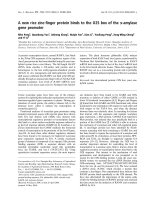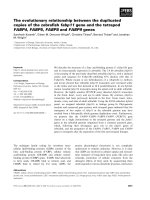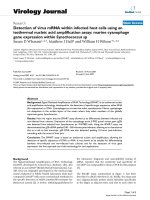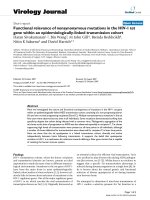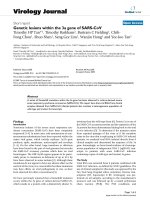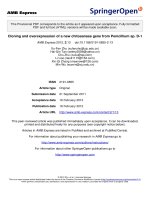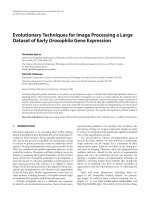evolutionary new centromeres preferentially emerge within gene deserts
Bạn đang xem bản rút gọn của tài liệu. Xem và tải ngay bản đầy đủ của tài liệu tại đây (594.31 KB, 12 trang )
Open Access
et al.
Lomiento
2008
Volume
9, Issue 12, Article R173
Research
Evolutionary-new centromeres preferentially emerge within gene
deserts
Mariana Lomiento*, Zhaoshi Jiang†, Pietro D'Addabbo*, Evan E Eichler†‡
and Mariano Rocchi*
Addresses: *Department of Genetics and Microbiology, University of Bari, Via Amendola 165/A, Bari 70126, Italy. †Department of Genome
Sciences, University of Washington School of Medicine Seattle, 1705 NE Pacific St, Seattle, WA 98195, USA. ‡Howard Hughes Medical Institute,
1705 NE Pacific St, Seattle, WA 98195, USA.
Correspondence: Mariano Rocchi. Email:
Published: 16 December 2008
Genome Biology 2008, 9:R173 (doi:10.1186/gb-2008-9-12-r173)
Received: 15 July 2008
Revised: 15 November 2008
Accepted: 16 December 2008
The electronic version of this article is the complete one and can be
found online at />© 2008 Lomiento et al.; licensee BioMed Central Ltd.
This is an open access article distributed under the terms of the Creative Commons Attribution License ( which
permits unrestricted use, distribution, and reproduction in any medium, provided the original work is properly cited.
Centromere
A
mates
study identifying
evolution genomic restructuring and the absence of genes as conditions permissive for the seeding of new centromeres in pri-
Abstract
Background: Evolutionary-new centromeres (ENCs) result from the seeding of a centromere at
an ectopic location along the chromosome during evolution. The novel centromere rapidly
acquires the complex structure typical of eukaryote centromeres. This phenomenon has played an
important role in shaping primate karyotypes. A recent study on the evolutionary-new centromere
of macaque chromosome 4 (human 6) showed that the evolutionary-new centromere domain was
deeply restructured, following the seeding, with respect to the corresponding human region
assumed as ancestral. It was also demonstrated that the region was devoid of genes. We
hypothesized that these two observations were not merely coincidental and that the absence of
genes in the seeding area constituted a crucial condition for the evolutionary-new centromere
fixation in the population.
Results: To test our hypothesis, we characterized 14 evolutionary-new centromeres selected
according to conservative criteria. Using different experimental approaches, we assessed the
extent of genomic restructuring. We then determined the gene density in the ancestral domain
where each evolutionary-new centromere was seeded.
Conclusions: Our study suggests that restructuring of the seeding regions is an intrinsic property
of novel evolutionary centromeres that could be regarded as potentially detrimental to the normal
functioning of genes embedded in the region. The absence of genes, which was found to be of high
statistical significance, appeared as a unique favorable scenario permissive of evolutionary-new
centromere fixation in the population.
Background
The centromere is a complex structure ensuring the proper
segregation of chromosomes in mitosis and meiosis. It usually harbors large blocks of satellite DNA (alpha satellite in
primates). In spite of their complexity, centromeres have
been shown to be able to relocate along the chromosome during evolution. These novel centromeres are referred to as evolutionary-new centromeres (ENCs). The first ENC examples
Genome Biology 2008, 9:R173
/>
Genome Biology 2008,
supported by molecular cytogenetic techniques were
described in non-human primates, in orthologs to human
chromosome 9 [1]. Since then, several other examples have
been reported in primates and other taxa [2-10]. The phenomenon implies the seeding of the novel centromere and the
inactivation of the old one.
The emergence of an ENC has been hypothesized to be epigenetic in nature, that is, not accompanied by any sequence
transposition. This conjectural view is supported by indirect
evidence, primarily by parallels with clinical cases of human
neocentromeres. These are ectopic, analphoid centromeres
usually originating in chromosomal acentric fragments allowing for their mitotic survival as supernumerary chromosomes
(for a review, see Marshall et al. [11]). They originate as
opportunistic events, secondary to a chromosomal rearrangement. The latter circumstance has been regarded as strong
evidence of their epigenetic nature. The detrimental phenotypic consequences of the aneuploid status frequently
incurred by neocentromeres is thought to limit germline
transmission and is, therefore, analogous to ENCs. Recently,
however, two familial transmissions of autosomal neocentromeres, occurring in apparently normal individuals with otherwise normal karyotypes, were described [5,12]. They have
been considered as ENCs at initial stages.
ENCs are relatively frequent. In macaque, for instance, 9 out
of 21 centromeres are evolutionarily new [6]; in donkey at
least 5 originated after a relatively short evolutionary timeframe since the donkey/zebra divergence (less than 1 million
years) [8]. The relatively high number of ENCs could suggest
a scenario where the absence of selective constraint allows
ENC fixation. The finding, in humans, that neocentromeres
do not affect gene expression [13-16] appears in line with this
view.
The insight on the progression dynamics of the ENC of
macaque chromosome 4 (MMU4, human 6), recently provided by Ventura et al. [6], has disclosed a potentially different evolutionary scenario in ENC formation. A DNA region of
approximately 250 kb was pinpointed as the ENC seeding
region and was shown to have been deeply affected by a variety of mutational processes, including extensive duplication
on both sides of the centromere, massive insertions of small
stretches of alpha-satellite DNA, and microdeletions inferred
by absence of specific STS (Sequence Tagged Site) amplification. It could be supposed that this process would strongly
antagonize ENC fixation because such structural variation
would significantly affect the physical integrity of genes or
regulatory elements located within the seeding region. Not
surprisingly, Ventura et al. [6] observed that this region was
devoid of genes. We hypothesized that this observation was
not coincidental but crucial in understanding the genomic
context of ENC formation.
Volume 9, Issue 12, Article R173
Lomiento et al. R173.2
To test this hypothesis, 14 primate ENCs were analyzed in
order to: ascertain the presence of novel segmental duplications (SDs) around the ENC suggestive of a restructuring
process of the kind reported by Ventura et al. [6]; and survey
the gene density in the seeding regions. Our analysis strongly
suggested that the restructuring of the neocentromeric region
is an intrinsic property of ENC progression and, consequently, the highly significant absence of genes we have
observed may represent a critical pre-requisite for ENC progression and fixation in the population. The 14 seeding
regions were also analyzed for AT content.
Results
Search for evolutionary new centromeres
Published studies and our unpublished data on chromosomal
evolution in primates were surveyed in the search for ENCs.
We identified 31 ENCs: 15 in Catarrhini (Old World monkeys
(OWMs) and Hominoidea) and 16 in Platyrrhini (New World
monkeys (NWMs)). The vast majority of the NWM ENCs
apparently emerged at the breakpoint of a chromosomal fission or repositioned from a telomere to the other telomere
(see, for instance, the evolution of chromosome 3 [5]). Centromeres of human acrocentrics 15 and 14 are examples of
ENCs that originated at a breakpoint and at a telomere,
respectively, following a chromosomal fission [3]. Their short
arms consist of several megabases of acquired sequences.
These circumstances suggested that telomeric ENCs could
represent a different ENC category, with different progression dynamics. We therefore excluded these ENCs from the
analysis and focused our investigation on the ENCs that
emerged inside a chromosome and were not concomitant to a
disruption of the seeding region.
Fourteen ENCs met these conservative criteria: one in woolly
monkey (Lagothrix lagothricha, LLA, Atelinae, NWM), eight
in OWMs [6], one in white-cheeked gibbon (Nomascus leucogenys, NLE) [17], one in orangutan (Pongo pygmaeus,
PPY) [18], and three in humans (Homo sapiens, HSA)
[5,18,19]. The ENC that emerged on chromosome 7 (human
8) of woolly monkey (NWM) has not been previously published. The evolutionary history of chromosome 8, supporting the emergence of an ENC in this primate, is summarized
in Additional data file 1; fluorescence in situ hybridization
(FISH) examples shown given in Additional data file 2a, b.
Bacterial artificial chromosome (BAC) clones used in the
analysis are reported in Additional data file 3. The eight ENCs
found in macaque (Cercopithecinae) are also present in the
silvered leaf monkey (Trachypithecus cristatus, TCR, Colobinae), indicating that all ENCs originated in the Cercopithecinae/Colobinae common ancestor. The rhesus macaque was
used as a representative of OWMs because its genome has
been fully sequenced [20].
Reiterative FISH experiments with corresponding human
BAC clones were performed in non-human primate met-
Genome Biology 2008, 9:R173
/>
Genome Biology 2008,
aphases in order to precisely map these ENCs on the human
sequence used as a reference (build35 assembly, March 2004;
an example is shown in Additional data file 2c). The macaque
sequence was used as a reference for the three human ENCs
(rheMac2 release, January 2006). The position of the human
ENCs in macaque was defined using macaque BAC clones
hybridized to human metaphases. The results are summarized in Table 1. In some cases a BAC generated split signals
on both sides of the centromere (Table 1, entries in bold),
while flanking BACs gave a single signal on the expected pericentromeric side. The sequence corresponding to the splitting
BAC was flagged as the ENC seeding region. In other cases the
Volume 9, Issue 12, Article R173
Lomiento et al. R173.3
position of the ENC was defined by two overlapping BACs
mapping on opposite sides of the ENC.
Ancestral organization of regions where ENCs were
seeded
The human regions orthologous to the sequence domains
where the non-human ENCs were seeded were investigated
for evolutionary conservation against mouse and dog
genomes by visually inspecting the University of California
Santa Cruz (UCSC) Comparative Genomics Net tracks [21].
The analysis was performed in order to validate the human
sequence as bona fide reference sequence with respect to the
changes the ENC regions underwent during evolution. We
Table 1
Definition of the ENC seeding region in the reference genome
Chromosome
ENC position
Size (kb) p arm BAC
Position in HSA
(hg17) or MMU
(rheMac2)
q arm BAC
Position in HSA
(hg17) or MMU
(rheMac2)
AT content (%)
Platirrhini
LLA7 (HSA8)
Chr8:63,002,31763,047,396
45
RP11-953L16
Chr8:62,816,38663,002,317
RP11-159F22
Chr8:63,047,39663,204,407
63.9
MMU2 (HSA3)
Chr3:164,221,008164,539,729
319
RP11-449O23
Chr3:164,054,860164,221,008
RP11-418B12
Chr3:164,539,729164,707,135
65.9
MMU4 (HSA6)
Chr6:145,651,644145,845,896
194
RP11-474A9
Chr6:145,651,644145,845,896
MMU12 (HSA2q) Chr2:138,847,788138,947,383
99
RP11-343I5
Chr2:138,777,146138,947,383
MMU13 (HSA2p) Chr2:86,680,78586,885,407
204
RP11-722G17
Chr2:86,680,78586,885,407
MMU14 (HSA11) Chr11:5,856,1815,864,725
8
RP11-625D10
Chr11:5,667,3395,864,725
RP11-661M13
Chr11:5,856,1816,043,020
62.8
MMU15 (HSA9)
46
RP11-64P14
Chr9:122,344,545122,532,865
RP11-1069J21
Chr9:122,486,836122,680,563
62.4
RP11-543A19
Chr13:61,111,76961,178,154
RP11-527N12 Chr13:62,520,87862,699,203
66.2
Catarrhini
Chr9:122,486,836122,532,865
63.2
RP11-846E22
Chr2:138,847,788139,025,935
63.1
60.0
MMU17 (HSA13) Chr13:61,178,15462,520,878
1,343
MMU18 (HSA18) Chr18:50,313,12950,360,135
47
RP11-61D1
Chr18:50,155,76150,313,129
RP11-289E15
Chr18:50,360,13550,526,341
gap
NLE15 (HSA11)
Chr11:89,446,99589,488,776
42
RP11-529A4
Chr11:89,286,31389,446,995
RP11-1129K7
Chr11:89,488,77689,644,713
63.8
PPY11 (HSA11)
Chr11:20,180,42420,332,556
152
RP11-56J22
Chr11:20,180,42420,332,556
HSA3 (MMU2)
Chr2:14,301,43414,386,749
85
CH250-111O10
Chr2:14,301,46614,396,994
HSA6 (MMU4)
Chr4: 57,710,48157,863,274
153
CH250-20M17 Chr4: 57,710,48157,863,274
HSA11 (MMU14) Chr14:17,109,97017,281,610
171
CH250-111J7
61.2
HSA
Chr14:17,015,71017,109,970
CH250-4J18
Chr2:14,386,74914,533,296
62.3
66.1
CH250-37N19
Chr14:17,281,61017,299,898
63.4
Seeding regions of the studied ENCs, defined by a splitting BAC (in bold) or by overlapping BACs mapping in opposite sides of the centromere (p
arm/q arm). In the latter case the overlapping portion of the two BACs was assumed as the seeding point. In MMU17 (human 13), several contiguous
human BACs gave split signals. The table lists the most external ones (in italics). The human genome was used as a reference genome for non-human
primate ENCs. The macaque genome was used as a reference for the three human ENCs (see text).
Genome Biology 2008, 9:R173
/>
Genome Biology 2008,
performed a similar comparative analysis for macaque
regions corresponding to the three human ENCs for which
the macaque was used as a reference. In both human and
macaque sequences, the analysis encompassed approximately 2 Mb on each side of the seeding point. Substantial differences were found only in mouse (breaks or inversions at
regions corresponding to human chromosome 2 (85.7-86.7
Mb and 137.6-137.7 Mb), chromosome 8 (61.9-62.8 Mb), and
chromosome 11 (88.4-89.2 Mb)). No rearrangements were
found in the dog, with the exception of the cluster of olfactory
receptor (OR) genes located at 121.5-122.3 Mb in human
chromosome 9 and absent in dog. The human/dog concordance strongly suggests that these rearrangements are derivative in mouse.
Platyrrhini
(NWM)
Volume 9, Issue 12, Article R173
Lomiento et al. R173.4
Tempo of evolutionary-new centromere seeding
As mentioned, all eight ENCs found in OWMs were present in
both macaque (Cercopithecinae) and silvered leaf monkey
(Colobinae) species. Therefore, all originated before the Cercopithecinae/Colobinae divergence (see Figure 1), estimated
to have occurred 16 million years ago (mya) [22]. The position
of the centromere on chromosomes orthologous to HSA2q
(MMU12), HSA13 (MMU17), and HSA18 (MMU18) is shared
by Hominoidea and NWMs [23] (unpublished data). The
ENC seeding on these chromosomes, therefore, occurred in
OWMs (Cercopithecoidea) after their divergence from Hominoidea (Figure 1), which was approximately 23 mya [22]. It
was not possible to precisely define the upper temporal limit
of the remaining OWM ENCs because the position of the centromere on orthologous NWM and Hominoidea chromosomes showed discrepancies [1,5,19].
Atelidae
Lagothrix
Cebidae
Callithrix
Macaque
Primates
Cercopythecinae
Cercopythecoidea
(OWM)
Chlorocebus
Trachypithecus
Colobinae
Catarrhini
Nomascus
Pan
Hominoidea
Hominidae
Homo
Gorilla
Pongo p.a.
Pongidae
5 mya
10 mya
15 mya
20 mya
40 mya
Pongo p.p.
Figure
The
phylogenetic
1
relationships of the species under study
The phylogenetic relationships of the species under study. Data on OWMs and Hominoidea are from Raaum et al. [22], while those on NWMs are
from Schneider et al. [24].
Genome Biology 2008, 9:R173
/>
Genome Biology 2008,
The ENC on orangutan chromosome 11 is Pongo-specific [18]
and is shared by both orangutan subspecies (Pongo pygmaeus abelii and Pongo pygmaeus pygmaeus). Consequently, it was seeded within the interval 4-14 mya (between
Pongidae/Hominidae and PPY abelii/PPY pygmaeus splits,
respectively). The HSA11 ENC is, very likely, Hominidae-specific [18]. Thus, it dates within the interval 8-14 mya (after
Pongidae/Hominidae split and before gorilla-pan-homo
divergence, respectively). HSA3 and HSA6 ENCs are shared
by great apes, so they date prior to 8 mya. Uncertainty on the
ancestral position of the centromere in these chromosomes
impinges on the uncertainty of the upper temporal limit of
their occurrence [5,19]. For the ENC of the woolly monkey
(LLA7, NWM, Atelidae), we could define only the upper temporal limit of 22-23 mya, which is the estimated divergence
time of the Atelidae (LLA) and Cebidae (CJA) lineages [24].
Search for segmental duplications around
evolutionary-new centromeres
SD analysis was straightforward for the three human ENCs
(chromosomes 3, 6 and 11) due to the high quality of the
sequence assembly within these human pericentromeric
Volume 9, Issue 12, Article R173
Lomiento et al. R173.5
regions [25]. Duplications were found in the pericentromeric
regions of all three human chromosomes. On chromosome 6
and particularly on chromosome 3, intrachromosomal duplications predominate. The duplication status of the sequenced
macaque and orangutan genomes is less accurate with respect
to humans because of the severe limitations intrinsic to the
whole genome shotgun (WGS) sequencing assembly
approach [26] in resolving high-identity duplications (note
that whole genome sequence data are not currently available
for the white-cheeked gibbon and woolly monkey).
To circumvent, at least in part, these problems, we exploited
complementary bioinformatic and molecular cytogenetic
techniques because they are partially 'assembly independent'.
First, we examined each of the ENC regions for the presence
of recent duplications in various primates using WGS
sequence detection (WSSD) [27], where whole genome shotgun (WGS) reads from each primate are mapped against the
human reference genome (hg17). Table 2 lists WSSD positive
intervals detected for each primate species. Segmental duplications were detected, for example, on MMU4 (HSA6),
MMU17 (HSA13), and PPY11 (HSA11). We then selected and
Table 2
Duplication analyses in ENC regions
Non-redundant WSSD base pair (bp)
ENC
Start (HAS hg17)
Start+1M
End (HS A hg17)
End+1M
Size
HSA
PTR
PPY
MMU
Narrow interval
MMU2 (HSA3)
164,221,008
164,539,729
318,722
0
0
0
0
MMU4 (HSA6)
145,651,644
145,845,896
194,253
0
0
0
104,409
MMU12 (HSA2)
138,847,788
138,947,383
99,596
0
0
0
0
MMU13 (HSA2)
86,680,785
86,885,407
204,623
24,002
0
0
0
MMU14 (HSA11)
5,856,181
5,864,725
8,545
0
0
0
0
MMU15 (HSA9)
122,486,836
122,532,865
46,030
0
0
0
0
MMU17 (HSA13)
61,178,154
62,520,878
1,342,725
24,879
15,879
103,912
85,133
MMU18 (HSA18)
50,313,129
50,360,135
47,007
0
0
0
0
PPY11 (HSA11)
20,180,424
20,332,556
152,133
0
0
126,135
0
Larger interval
MMU2 (HSA3)
163,221,008
165,539,729
2,318,722
0
0
0
24,053
MMU4 (HSA6)
144,651,644
146,845,896
2,194,253
0
0
0
115,053
MMU12 (HSA2)
137,847,788
139,947,383
2,099,596
0
0
17,001
1,706
MMU13 (HSA2)
85,680,785
87,885,407
2,204,623
1,227,738
309,321
0
19,317
MMU14 (HSA11)
MMU15 (HSA9)
4,856,181
6,864,725
2,008,545
0
0
13,379
0
121,486,836
123,532,865
2,046,030
0
0
0
0
MMU17 (HSA13)
60,178,154
63,520,878
3,342,725
160,4637
98,004
144,056
85,133
MMU18 (HSA18)
49,313,129
51,360,135
2,047,007
0
0
0
0
PPY11 (HSA11)
19,180,424
21,332,556
2,152,133
0
0
784,808
0
We estimated the number of duplicated base-pairs predicted in each of the ENC intervals using the WSSD method; duplications >10 kb and >94%
were detected with the exception of the macaque, where a threshold of >88% was used due to the greater sequence divergence of the human and
macaque genomes. The analysis was performed separately for each of the four primate species. Two different ENC intervals were considered: a
narrow interval, as defined in Table 1 (upper dataset) and a larger interval adding 1 Mbp to each side of the region (lower dataset).
Genome Biology 2008, 9:R173
/>
Genome Biology 2008,
tested various BAC clones by FISH. Some duplication data
already resulted from experiments aimed at identifying the
seeding region using human BAC clones (see above). However, split signals on both sides of the centromere could be
alternatively interpreted as due to a disruption of distinct,
non-duplicated sequences composing the human BAC, as a
consequence of the colonization of alpha satellite DNA. Additionally, orthologous human clones may not be suitable for
the analysis because of the restructuring process that could
have substantially altered the pericentromeric sequences
within each species. Final, new material, not represented in
human BACs, may exist within these locations due to lineagespecific interchromosomal duplications.
Considering these potential biases, we also selected speciesspecific BAC clones identified with different approaches. For
macaque we took advantage of the data on MMU BAC clones
available at the Bioinformatics Research Laboratory of the
Baylor College of Medicine, Houston, TX, USA [28]. For orangutan (PPY) and white-checked gibbon (NLE), we queried
appropriate BAC-end sequences from CHORI-276 (PPY) and
CHORI-271 (NLE) BAC libraries using the Trace Archive
database of the NCBI [29]. A BAC library was not available for
the woolly monkey (LLA). The phylogenetic distance of this
NWM species coupled with the potential degenerative consequences of pericentromeric restructuring processes
prompted us to discard the woolly monkey from the pericentromeric duplication analysis. Relevant FISH results of species-specific BAC clones yielding duplicated signals around
the ENCs are reported in Table 3 (all tested clones are given
Volume 9, Issue 12, Article R173
Lomiento et al. R173.6
in Additional data file 4); examples are shown in Figure 2 and
Additional data file 2e, f. We discovered pericentromeric
duplications mapping near the centromeres for almost all
ENCs. One BAC-end of asterisked BACs in Table 3 and Additional data file 4 was identified by RepeatMasker as entirely
composed of 171 bp alpha satellite repeats. No internal repeat
was found truncated, and the homology with the apha satellite consensus ranged from 75% to 90%.
Two findings were of particular interest. Four nearly overlapping human BACs (RP11-543A19, -1043D14, -539I23, and 527N12) covering a region of 1.3 Mb (chr13: 61,111,76962,699,203) around the MMU17 ENC gave duplicated signals
around the centromere. Additionally, the two human BACs
defining the ENC of MMU2 (HSA3) are 319 kb apart (Table 1).
Three BACs spanning this interval (RP11-1089F10, -1142P11,
and -10O22) failed to give any FISH signals in macaque, suggesting a deletion of the corresponding region within the
macaque lineage. To exclude the possibility of a technical artifact, we mixed on the same slide human and macaque metaphases, added an excess of probe, and extended the
hybridization time for three days. Again in these conditions,
no signal was detected in macaque metaphases, while strong
signals were present in human metaphases. We performed a
BLAST sequence similarity using the human 319 kb region as
query against macaque sequences deposited in the Trace
Archive database [29]. Only very small stretches (less than 1
kb) of homologous DNA were found externally located with
respect to a central chr3:164,271,000-164,461,000 region
(190 kb) in which no homology was detected (data not
(b)
(a)
MMU12
CH250-158G21
MMU14
CH250-449K18
MMU15
CH250-221O11
MMU17
CH250-299M13
MMU18
CH250-322J16
NLE15
CH271-140J13
CH250-417O7
Figure
FISH
examples
2
FISH examples. (a) Examples of FISH experiments using species-specific BAC clones yielding duplicated signals around the centromere. The CH250 and
CH271 are BAC libraries specific for macaque and gibbon, respectively. The DAPI-stained chromosome without the signal is reported on the left to better
show the morphology of the chromosome. (b) FISH experiment using the BAC clone CH250-417O7 (MMU2) on a macaque metaphase, showing
pericentromeric signals on several chromosomes.
Genome Biology 2008, 9:R173
/>
Genome Biology 2008,
Table 3
Species-specific BACs yielding duplicated signals oround ENCs
ENC
MMU13 (HSA2p)
MMU12 (HSA2q)
BAC
Position in HSA (May 2004)
CH250-565F19*
Chr2:86,755,212-alphoid
CH250-417O7
Chr2:86,785,727-repeat
CH250-371E19*
Chr2:86,870,586-alphoid
CH250-359C1
Chr2:138,344,201-138,510,183
CH250-158G21
Chr2:138,478,651-138,621,067
CH250-18F12*
Chr2:138,643,711-alphoid
Volume 9, Issue 12, Article R173
Lomiento et al. R173.7
most proximal and distal RefSeq genes with respect to the
ENC seeding point. The distance between the two genes is
reported in the second column. Clusters of olfactory receptor
genes flank the ENCs of chromosomes MMU14 (HSA11),
MMU15 (HSA9), and HSA11 (MMU14). These OR clusters
were not considered because OR genes are extremely redundant and a large number of these are pseudogenic within the
primate lineage. The inactivation of a few of them would
unlikely have strong phenotypical consequences. It is worth
noting, in this context, that more than half of OR genes
became inactive in recent human evolution [30].
AT content
MMU14 (HSA11)
CH250-444O7*
Chr11:5,861,684-alphoid
CH250-499K18*
Chr11:6,038,164-alphoid
MMU15 (HSA9)
CH250-221O11*
Chr9:122,220,400-alphoid
MMU17 (HSA13)
CH250-310C22
Chr13:61,479,136-61,591,608
CH250-299M13
Chr13:61,503,914-61,617,441
CH250-115C9
Chr13:61,540,997-61,676,877
MMU18 (HSA18)
CH250-322J6
Chr18:50,437,322-repeat
NLE15 (HSA11)
CH271-140J13
Chr11:89,572,864-repeat
Species-specific BAC clones yielding duplicated signals around the
ENC. Their specific pericentromeric location, confirmed by FISH, was
derived by their BAC-end(s) mapping. *One BAC-end of these BACs is
entirely composed of alphoid repeats. The FISH signal, however, was
not centromeric, indicating that the alphoid content of the BAC was
marginal. See Figure 1 for examples.
shown). Additionally, the macaque BAC clone CH250-91J4,
identified at the Baylor College database (see above), mapping at HSA chr3:164,777,357-164,967,209, which is slightly
external to the 'deleted' region, failed to yield any signal in
human metaphases (data not shown). Altogether, these data
strongly suggest that the region is highly rearranged in
macaque.
Gene content at evolutionary-new centromere regions
We carefully analyzed the human genome (used as reference
for non-human ENCs) and the macaque genome (used as reference for the three human ENCs) for annotated genes mapping within, or in proximity of, ENC seeding regions. The
analysis was performed by querying the human and macaque
RefSeq-related tracks of the UCSC genome browser [21] (hg17
assembly, RheMac2 assembly). No RefSeq genes were identified within the seeding regions as defined above (Table 1). In
order to assess the statistical significance of gene depletion in
the regions where ENCs were seeded, we performed a gene/
exon density simulation (see Materials and methods) for 14
ENC regions. We found that the gene/exon density of the 14
ENCs is significantly depleted (p < 0.0001) when compared
to random simulated data (Figure 3a-c). Table 4 reports the
The precise location of some human neocentromeres has
been achieved through CENP-A mapping by chromatin
immunoprecipitation (ChIP)-on-chip experiments (reviewed
by Marshall et al. [11]). AT content has been shown to be one
of the few common features shared by these neocentromeres.
We calculated the AT content for the human domains corresponding to the ENC seeding regions as defined in Table 1.
The results are reported in the last column of Table 1.
Discussion
The organization, evolution and function of eukaryotic centromeres represent a deficiency in our understanding of
genome biology. The discovery of human clinical neocentromeres and ENCs has further complicated, on one hand, our
understanding of the centromere. On the other hand, neocentromeres and ENCs have allowed an initial dissection of centromere complexity. They have made evident, for instance, its
epigenetic nature. The ENC analysis we have accomplished in
the present study has contributed to the identification of factors that, very likely, play a crucial role in ENC progression
and fixation in the population. We have provided strong evidence that the pericentromeric duplication activity is an
intrinsic property of ENCs. This conclusion was mainly supported by FISH experiments using species-specific BAC
clones that detected SDs around the centromere in almost all
studied ENCs. A deep restructuring was particularly evident
in MMU17 (human 13) and MMU2 (human 3). The latter ENC
showed a large deletion. This observation is not unexpected
and could be generated by allelic non-homologous recombination occurring in one side of the centromere. Our overall
results indicate that deep restructuring is a feature inherent
to pericentromeric duplication activity triggered by the ENCs.
Our analysis also indicated that species-specific probes are
the most appropriate for detecting potential interchromosomal duplications (see ENCs of MMU12, 13, 14, 15 and 17).
Contrary to what we detected in the ENC of MMU4 (human
6), where SDs were strictly intrachromosomal [6], we found
that SDs associated with other ENCs were both inter- and
intrachromosomal (for example, Figure 2b). Pericentromeric
analysis in humans has indicated that the majority of SDs are
interchromosomal. It could be hypothesized that intrachro-
Genome Biology 2008, 9:R173
/>
Genome Biology 2008,
(a)
Volume 9, Issue 12, Article R173
Lomiento et al. R173.8
(Observed 1.5 genes/Mb, P<0.0001)
Number of Replicates (10,000)
2500
2000
1500
1000
500
0
0
1
2
3
4
5
6
7
8
9
10
11
12
13
14
15
16
17
18
19
20
ReSeq genes/Mb
(b)
(Observed 6 exons/Mb, P<0.0001)
500
Number of Replicates (10,000)
450
400
350
300
250
200
150
100
50
17
0
18
0
19
0
68
0
72
0
76
0
15
0
16
0
14
0
12
0
13
0
11
0
90
10
0
80
60
70
50
40
30
20
0
10
0
RefSeq exons/Mb
(c)
(Observed 93 exons/Mb, P<0.0001)
500
Number of Replicates (10,000)
450
400
350
300
250
200
150
100
50
64
0
60
0
56
0
52
0
48
0
44
0
40
0
36
0
32
0
28
0
24
0
20
0
16
0
80
12
0
0
40
0
Est exons/Mb
Figure
Gene
density
3
simulations
Gene density simulations. The observed density of (a) genes (Refseq), (b) Refseq exons and (c) expressed sequence tag (Est) exons within the
corresponding region of the 14 ENCs were compared against a simulated set of 10,000 regions distributed randomly within the human genome (see
Materials and methods). A significant depletion of exons and genes was observed.
Genome Biology 2008, 9:R173
/>
Genome Biology 2008,
Volume 9, Issue 12, Article R173
Lomiento et al. R173.9
Table 4
RefSeq genes flanking the ENCs
ENC
Interval (Mb) Left gene
Position in HSA (hg17) or
MMU (rheMac2)
Right gene
Position in HSA (hg17) or
MMU (rheMac2)
Platirrhini
LLA7 (HSA8)
0.534
ASPH
Chr8:62,699,65262,789,681
FAM77D
Chr8:63,324,05564,074,765
MMU2 (HSA3)
3.607
C3orf57
Chr3:162,545,283162,572,573
SI
Chr3:166,179,388166,278,984
MMU4 (HSA6)
0.772
UTRN
Chr6:144,654,566145,215,861
EPM2A
Chr6:145,988,141146,098,684
MMU13 (HSA2p)
0.097
RNF103
Chr2:86,742,17486,762,636
RMD5A
Chr2:86,859,35186,914,090
Catarrhini
MMU14 (HSA11)
1.213
MMP26
Chr11:4,966,000-4,970,233
C11orf42
Chr11:6,183,374-6,188,935
MMU15 (HSA9)
0.423
PTGS1
Chr9:122,212,783122,237,535
PDCL
Chr9:122,660,178122,670,394
MMU12 (HSA2q)
0.485
HNMT
Chr2:138,555,540138,607,665
LOC339745
Chr2:139,093,103139,164,532
MMU17 (HSA13)
4.888
PCDH20
Chr13:60,881,82260,887,282
PCDH9
Chr13:65,774,96866,702,464
MMU18 (HSA18)
0.247
C18orf54
Chr18:50,139,16950,162,379
C18orf26
Chr18:50,409,38850,417,722
NLE14 (HSA11)
2.746
CHORDC1
Chr11:89,574,26589,595,854
MTNR1B
Chr11:92,342,43792,355,596
PPY11 (HSA11)
0.203
DBX1
Chr11:20,134,33620,138,446
HTATIP2
Chr11:20,341,92420,361,904
0.641
EPHA3 in HSA (not
annotated in
Chr3:89,239,36489,613,972
PROS1 (L31380 in MMU)
Chr3:95,074,64795,175,395
HSA
HSA3 (MMU2)
MMU)
(MMU2:13,335,59313,694,578)
HSA6 (MMU4)
0.897
PRIM2A in HAS (not
annotated in
MMU)
(Chr2:14,335,82414,391,596)
Chr6:57,290,38157,621,334
KHDRBS2 in HAS (not
annotated in
Chr6:62,447,82463,054,091
(2 dup in MMU:
MMU)
(3 dup in MMU:
MMU4:56,935,67357,245,600
Chr4:58,142,81958,698,705
MMU11:20,043,34220,044,345)
Chr17:3,473,312-3,473,395
Chr8:138,072,498138,196,040)
HSA11 (MMU14)
1.280
LRRC55 in HAS (not
annotated in
Chr11:56,705,79756,714,154
PTPRJ in HAS
(not annotated in MMU)
Chr11:47,958,68948,146,246
MMU)
(MMU14:16,226,17516,234,557)
(Chr14:23,931,87124,124,487)
Position of the most proximal and distal genes with respect to each ENC seeding region, calculated in the reference genome (see text). The interval
size, in Mb, between the two genes is reported in column 2.
mosomal duplications arose first, followed by interchromosomal ones. This interpretation, however, clashes with the
finding, in humans, that the interchromosomal versus intrachromosomal SD ratio usually increases approaching the centromere, with the exception of few chromosomes [31].
Interestingly, three of these exceptions (chromosomes 3, 6
and, partially, 11) correspond to ENCs. It can be hypothesized
that these differences could be a reflection of the age of the
ENCs. Intrachromosomal SDs occur first but then as centromeres become established they begin to exchange between
Genome Biology 2008, 9:R173
/>
Genome Biology 2008,
non-homologous chromosomes, such that eventually interchromosomal duplications outnumber the intrachromosomal.
Studies on selected human neocentromeres have shown that
the chromatin remodeling accompanying the neocentromere
seeding does not alter gene expression [13-16]. By analogy
with ENCs, the presence of genes would not negatively affect,
per se, ENC function. Our studies suggest that the subsequent
duplication activity, implying deep restructuring, would, on
the contrary, antagonize ENC fixation. In this scenario, the
only condition compatible with ENC fixation in the population would be either the lack of genes in the ENC seeding
region or the presence of multi-copy gene family where loss
would be tolerated. The study provided strong support for
this scenario: the ENC seeding regions we have examined are
significantly depleted of genes. The MMU17 (HSA13) ENC is
of relevance in this context. It exhibits the largest gene desert
(4.9 Mb) and one of the largest duplicated regions (1.3 Mb).
The non-casual matching is further reinforced by the analysis
of the pattern of SDs around this repositioned centromere in
three distinct regions showing large-scale variation in OWM
species as reported by Cardone et al. [23]. This extensive variation could be interpreted as further evidence of relaxed constraint on duplication activity due to the large size of the gene
desert.
In an individual heterozygous for an ENC, a meiotic exchange
within the region delimited by the old and the novel centromeres would produce dicentric and acentric chromosomes,
mimicking the consequences of a pericentric inversion. These
events are supposed to affect the fitness of heterozygous carriers negatively. Meiotic drive in females in favor of the repositioned chromosome is a possible explanation, as reported
for Robertsonian fusion in humans [32]. Genetic drift and
population structure can also be hypothesized to have played
an important role in neocentromere fixation.
The AT content of all gene deserts flanking the ENCs was
higher than 59%, that is, the average of the entire human
genome [33] (see last column of Table 1). These findings,
however, could just reflect the high AT content of gene-poor
regions.
Conclusion
Our study strongly supports the hypothesis that the evolutionary fate of a repositioned centromere is largely dependent
upon a low gene density of the seeding region. This feature
appears to be the consequence of the peculiar dynamics of
ENC progression associated with extensive restructuring of
the region, including deletions, that can be assumed as potentially detrimental in genic regions of the genome.
Volume 9, Issue 12, Article R173
Lomiento et al. R173.10
Materials and methods
Cell lines
Metaphase preparations were obtained from cell lines (lymphoblasts or fibroblasts) from the following ape species: common chimpanzee (Pan troglodytes, PTR), gorilla (Gorilla
gorilla, GGO), Bornean orangutan (Pongo pygmaeus pygmaeus, PPY), white-cheeked gibbon (Nomascus leucogenys,
NLE). OWMs: rhesus monkey (Macaca mulatta, MMU),
vervet monkey (Chlorocebus aethiops, CAE, Cercopithecinae), silvered leaf monkey (Trachypithecus cristatus, TCR,
Colobinae). NWMs: wooly monkey (Lagothrix lagothricha,
LLA, Atelidae), common marmoset (Callithrix jacchus, CJA,
Callitricidae).
FISH experiments
DNA extraction from BACs was reported previously [2]. Cohybridization FISH experiments were performed essentially
as described by Lichter et al. [34]. To suppress cross-hybridization signals due to repeat sequences, COT1 DNA (5 μg) was
added to the hybridization mixture. Digital images were
obtained using a Leica DMRXA2 epifluorescence microscope
equipped with a cooled CCD camera (Princeton Instruments,
Princeton, NJ, USA). Cy3-dUTP, Fluorescein-dCTP, Cy5dCTP and DAPI fluorescence signals, detected with specific
filters, were recorded separately as grayscale images. Pseudocoloring and merging of images were performed using Adobe
Photoshop™ software.
BAC-end sequence analysis
BAC-end sequences were retrieved from the Trace Archive
database [29]. They were then analyzed using the RepeatMasker software [35] in order to identify BAC-ends partially or
entirely composed of repeat sequences. The software provides
information on the extension and type of repeat.
Primate segmental duplication characterization in
ENC regions
In order to identify segmental duplication content in various
primates, we used the previously described assembly-independent approach (WSSD) where WGS sequence reads [27]
from each query primate genome were mapped against
regions from the human genome reference sequence
(build35) corresponding to the ENCs. We considered regions
of excess WGS read depth (≥ mean + 1.5 × standard deviation)
to represent putative duplicated regions in each primate. Due
to different genomic sequence divergences between each primate and the human reference sequence, we used sequence
identity thresholds of ≥ 88% to map macaque reads while ≥
94% was used for alignment of reads from chimpanzee and
orangutan.
Gene/exon density simulation
In order to statistically assess the depletion of gene/exon density in the regions where ENCs were seeded, we performed
the gene/exon density simulation as follows. First, we computed the average gene/exon density for the 14 ENC regions
Genome Biology 2008, 9:R173
/>
Genome Biology 2008,
based on their annotation within the human genome. This
became our observed value for gene/exon density within ENC
regions (red line in Figure 3). Next, we randomly selected the
same number of gap-free base-pairs (23.2 Mbp) from the
human genome and computed the average gene/exon density
for these randomly selected intervals. We generated 10,000
replicates and plotted the distribution of gene/exon density
based on this simulation. We computed an empirical p-value
as the number of replicates with gene/exon density equal to
or lower than the observed density in 10,000 replicates. We
repeated the analysis excluding ENCs that had been identified within the human lineage of evolution (n = 3) and
obtained similar results (data not shown). For genes, we considered the position of all human non-redundant genes (RefSeq gene n = 22,589) and their corresponding exons as
determined by the UCSC genome browser [21]. As a second
analysis to assess transcript density, we independently
mapped the location of all spliced human ESTs (n =
4,246,559) to the human genome (build35) and selected the
location of the highest alignment score. If an EST/transcript
mapped to two or more locations with an equivalent score,
one was selected at random, such that each transcript was
assigned once and only once to the human genome. As part of
this analysis, we clustered exons that overlapped as a result of
alternative splicing and counted each cluster as a single exon.
MiUR (Ministero Italiano della Universita' e della Ricerca) is gratefully
acknowledged for financial support. This work was also supported by NIH
grant GM058815 to EEE and a Rosetta Inpharmatics Fellowship (Merck Laboratories) to ZJ. EEE is an investigator of the Howard Hughes Medical Institute.
References
1.
2.
3.
4.
5.
6.
7.
Abbreviations
Authors' contributions
ML planned and carried out the molecular cytogenetic experiments; PD analyzed the bioinformatic data; ZJ and EEE performed the statystical analysis; MR designed and coordinated
the study and wrote the paper. All authors read and approved
the final manuscript.
9.
10.
11.
12.
13.
14.
Additional data files
The following additional data are available with the online
version of thispaper. Additional data file 1 illustrates the evolutionary history of chromosome 8 in primates. Additional
data file 2 provides examples of FISH experiments. Additional data file 3 lists the human probes used to track the evolutionary history of chromosome 8. Additional data file 4 lists
the species-specific BAC clones used in FISH experiments to
detect pericentromeric segmental duplications.
Evolutionary
Examples
Human
some
Additional
Species-specific
pericentromeric
Click
here
8.
8 probes
of
for
data
FISH
history
file
used
file
BAC
segmental
experiments.
experiments
1to
2
3
4
of
clones
track
chromosome
duplications.
duplications
used
the evolutionary
in FISH
8 in primates.
primates
experiments
history oftochromodetect
Lomiento et al. R173.11
Acknowledgements
8.
BAC: bacterial artificial chromosome; ChIP: chromatin
immunoprecipitation; ENC: evolutionary-new centromere;
FISH: fluorescence in situ hybridization; mya, million years
ago; NWM: New World monkey; OR: olfactory receptor;
OWM: Old World monkey; SD: segmental duplication;
UCSC: University California Santa Cruz; WGS: whole genome
shotgun; WSSD: WGS sequence detection.
Volume 9, Issue 12, Article R173
15.
16.
17.
18.
Montefalcone G, Tempesta S, Rocchi M, Archidiacono N: Centromere repositioning. Genome Res 1999, 9:1184-1188.
Ventura M, Archidiacono N, Rocchi M: Centromere emergence
in evolution. Genome Res 2001, 11:595-599.
Ventura M, Mudge JM, Palumbo V, Burn S, Blennow E, Pierluigi M,
Giorda R, Zuffardi O, Archidiacono N, Jackson MS, Rocchi M: Neocentromeres in 15q24-26 map to duplicons which flanked an
ancestral centromere in 15q25.
Genome Res 2003,
13:2059-2068.
Carbone L, Ventura M, Tempesta S, Rocchi M, Archidiacono N: Evolutionary history of chromosome 10 in primates. Chromosoma
2002, 111:267-272.
Ventura M, Weigl S, Carbone L, Cardone MF, Misceo D, Teti M,
D'Addabbo P, Wandall A, Björck E, de Jong P, She X, Eichler EE,
Archidiacono N, Rocchi M: Recurrent sites for new centromere
seeding. Genome Res 2004, 14:1696-1703.
Ventura M, Antonacci F, Cardone MF, Stanyon R, D'Addabbo P, Cellamare A, Sprague LJ, Eichler EE, Archidiacono N, Rocchi M: Evolutionary formation of new centromeres in macaque. Science
2007, 316:243-246.
Band MR, Larson JH, Rebeiz M, Green CA, Heyen DW, Donovan J,
Windish R, Steining C, Mahyuddin P, Womack JE, Lewin HA: An
ordered comparative map of the cattle and human
genomes. Genome Res 2000, 10:1359-1368.
Carbone L, Nergadze SG, Magnani E, Misceo D, Francesca Cardone
M, Roberto R, Bertoni L, Attolini C, Francesca Piras M, de Jong P,
Raudsepp T, Chowdhary BP, Guerin G, Archidiacono N, Rocchi M,
Giulotto E: Evolutionary movement of centromeres in horse,
donkey, and zebra. Genomics 2006, 87:777-782.
Kasai F, Garcia C, Arruga MV, Ferguson-Smith MA: Chromosome
homology between chicken (Gallus gallus domesticus) and the
red-legged partridge (Alectoris rufa); evidence of the occurrence of a neocentromere during evolution. Cytogenet Genome
Res 2003, 102:326-330.
Kobayashi T, Yamada F, Hashimoto T, Abe S, Matsuda Y, Kuroiwa A:
Centromere repositioning in the X chromosome of XO/XO
mammals, Ryukyu spiny rat. Chromosome Res 2008, 16:587-593.
Marshall OJ, Chueh AC, Wong LH, Choo KH: Neocentromeres:
new insights into centromere structure, disease development, and karyotype evolution. Am J Hum Genet 2008,
82:261-282.
Amor DJ, Bentley K, Ryan J, Perry J, Wong L, Slater H, Choo KH:
Human centromere repositioning "in progress". Proc Natl
Acad Sci USA 2004, 101:6542-6547.
Yan H, Ito H, Nobuta K, Ouyang S, Jin W, Tian S, Lu C, Venu RC,
Wang GL, Green PJ, Wing RA, Buell CR, Meyers BC, Jiang J:
Genomic and genetic characterization of rice Cen3 reveals
extensive transcription and evolutionary implications of a
complex centromere. Plant Cell 2006, 18:2123-2133.
Nagaki K, Cheng Z, Ouyang S, Talbert PB, Kim M, Jones KM, Henikoff
S, Buell CR, Jiang J: Sequencing of a rice centromere uncovers
active genes. Nat Genet 2004, 36:138-145.
Lam AL, Boivin CD, Bonney CF, Rudd MK, Sullivan BA: Human centromeric chromatin is a dynamic chromosomal domain that
can spread over noncentromeric DNA. Proc Natl Acad Sci USA
2006, 103:4186-4191.
Saffery R, Sumer H, Hassan S, Wong LH, Craig JM, Todokoro K,
Anderson M, Stafford A, Choo KH: Transcription within a functional human centromere. Mol Cell 2003, 12:509-516.
Roberto R, Capozzi O, Wilson RK, Mardis ER, Lomiento M, Tuzun E,
Cheng Z, Mootnick AR, Archidiacono N, Rocchi M, Eichler EE:
Molecular refinement of gibbon genome rearrangement.
Genome Res 2007, 17:249-257.
Cardone MF, Lomiento M, Teti MG, Misceo D, Roberto R, Capozzi
O, D'Addabbo P, Ventura M, Rocchi M, Archidiacono N: Evolutionary history of chromosome 11 featuring four distinct centromere repositioning events in Catarrhini. Genomics 2007,
Genome Biology 2008, 9:R173
/>
19.
20.
21.
22.
23.
24.
25.
26.
27.
28.
29.
30.
31.
32.
33.
34.
35.
Genome Biology 2008,
90:35-43.
Eder V, Ventura M, Ianigro M, Teti M, Rocchi M, Archidiacono N:
Chromosome 6 phylogeny in primates and centromere
repositioning. Mol Biol Evol 2003, 20:1506-1512.
Gibbs RA, Rogers J, Katze MG, Bumgarner R, Weinstock GM, Mardis
ER, Remington KA, Strausberg RL, Venter JC, Wilson RK, Batzer MA,
Bustamante CD, Eichler EE, Hahn MW, Hardison RC, Makova KD,
Miller W, Milosavljevic A, Palermo RE, Siepel A, Sikela JM, Attaway T,
Bell S, Bernard KE, Buhay CJ, Chandrabose MN, Dao M, Davis C,
Delehaunty KD, Ding Y, et al.: Evolutionary and biomedical
insights from the rhesus macaque genome. Science 2007,
316:222-234.
University of California Santa Cruz Genome Bioinformatics
[]
Raaum RL, Sterner KN, Noviello CM, Stewart CB, Disotell TR:
Catarrhine primate divergence dates estimated from complete mitochondrial genomes: concordance with fossil and
nuclear DNA evidence. J Hum Evol 2005, 48:237-257.
Cardone MF, Alonso A, Pazienza M, Ventura M, Montemurro G, Carbone L, de Jong PJ, Stanyon R, D'Addabbo P, Archidiacono N, She X,
Eichler EE, Warburton PE, Rocchi M: Independent centromere
formation in a capricious, gene-free domain of chromosome
13q21 in Old World monkeys and pigs. Genome Biol 2006,
7:R91.
Schneider H, Canavez FC, Sampaio I, Moreira MA, Tagliaro CH,
Seuanez HN: Can molecular data place each neotropical monkey in its own branch? Chromosoma 2001, 109:515-523.
She X, Horvath JE, Jiang Z, Liu G, Furey TS, Christ L, Clark R, Graves
T, Gulden CL, Alkan C, Bailey JA, Sahinalp C, Rocchi M, Haussler D,
Wilson RK, Miller W, Schwartz S, Eichler EE: The structure and
evolution of centromeric transition regions within the
human genome. Nature 2004, 430:857-864.
Eichler EE: Segmental duplications: what's missing, misassigned, and misassembled-and should we care? Genome Res
2001, 11:653-656.
Bailey JA, Gu Z, Clark RA, Reinert K, Samonte RV, Schwartz S, Adams
MD, Myers EW, Li PW, Eichler EE: Recent segmental duplications in the human genome. Science 2002, 297:1003-1007.
Bioinformatics Research Laboratory of the Baylor College of
Medicine, Houston, TX
[ />dataAccess.rhtml]
National Center for Biotechnology Information
[http://
www.ncbi.nlm.nih.gov/Traces]
Gilad Y, Bustamante CD, Lancet D, Paabo S: Natural selection on
the olfactory receptor gene family in humans and chimpanzees. Am J Hum Genet 2003, 73:489-501.
Bailey JA, Yavor AM, Massa HF, Trask BJ, Eichler EE: Segmental
duplications: organization and impact within the current
human genome project assembly.
Genome Res 2001,
11:1005-1017.
Pardo-Manuel de Villena F, Sapienza C: Transmission ratio distortion in offspring of heterozygous female carriers of Robertsonian translocations. Hum Genet 2001, 108:31-36.
Lander ES, Linton LM, Birren B, Nusbaum C, Zody MC, Baldwin J,
Devon K, Dewar K, Doyle M, FitzHugh W, Funke R, Gage D, Harris
K, Heaford A, Howland J, Kann L, Lehoczky J, LeVine R, McEwan P,
McKernan K, Meldrim J, Mesirov JP, Miranda C, Morris W, Naylor J,
Raymond C, Rosetti M, Santos R, Sheridan A, Sougnez C, et al.: Initial
sequencing and analysis of the human genome. Nature 2001,
409:860-921.
Lichter P, Tang Chang C-J, Call K, Hermanson G, Evans GA, Housman
D, Ward DC: High resolution mapping of human chromosomes 11 by in situ hybridization with cosmid clones. Science
1990, 247:64-69.
RepeatMasker [ />
Genome Biology 2008, 9:R173
Volume 9, Issue 12, Article R173
Lomiento et al. R173.12


